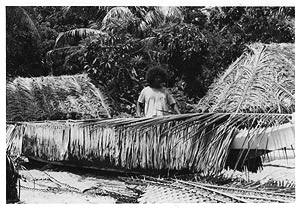The Project

Having seen the beauty and sailing qualities of the first sailing Child of the Sea we strongly feel that this boat should now be returned to the people who inspired her, i.e. the Tikopians. This boat will make an ideal communication vessel between Tikopia, Anuta, Vanikoro, the Banks and the Solomon Islands, she can even be sailed to Fiji where many young Tikopians go to study. She is driven by sails and paddles (when necessary), requiring no fuel, though a small outboard motor could be fitted for emergencies. The rig is the traditional Tikopian/Polynesian ‘Crabclaw’ rig that can be hand stitched (from low cost fabric, as done in Indonesia) by the locals. Crossbeams, spars, centre decking and steering paddles can be made of locally grown timber.
The hulls are not made the traditional way out of a dugout log. Such logs are now very scarce and mostly not large enough to make a seagoing canoe. We therefore designed the hulls to be built out of strip planking over a plywood framework of backbone and bulkheads, which accurately determines the shape of the hull. All the wood is glued and sealed with epoxy resin and glass cloth, this makes the hulls very durable so that with some minor maintenance and painting they can last 25 years plus. Strip planking gives a result and shape closest to a dug out hull and we can replicate the subtle carving of the hull, bow and stern details accurately.
The building of the Canoe for Tikopia
Building this boat in Tikopia or Anuta would not be practical, as all materials would have to be imported and the people at present lack skills in building with these type of modern materials. We therefore propose that the hulls be built by our professional builder in the Southern Philippines (near Bohol) and his team of Filipino workers, who have already built the first Child of the Sea sailing. We would like to have a few selected Tikopians/Anutans participate in the building process, alongside the trained Filipino builders, if they can get permission from the Solomon Islands government to spend time in the Philippines. We would suggest some young enthusiasts, male and female, as well as one or two older men with knowledge of past canoe building or wood working/carving skills. They could bring some local timber with them to make the steering paddles, which they should carve themselves to give them Mana. They would also be responsible for sewing the sails and rigging her, with our help if necessary.
Participation by all the people on the islands of Tikopia and Anuta
It would be good if the people on the islands, particularly the schoolchildren, the new generation that will be sailing the boat, can be involved in the project. At its most basic there could be a regular radio broadcast from the Philippines. A satellite link with a computer on the island would be even more interesting, though we mustn’t corrupt the sustainability of Tikopian society by bringing in high tech 21st Century equipment and all the paraphernalia needed to run it. Until now the most high tech piece of equipment on Tikopia is the battery powered transistor radio.
The voyage to Tikopia
Once the canoe is finished and had sailing trials she is ready to make the voyage to Tikopia. The route of this voyage is the same as the Polynesian ancestors made 3000 years ago and follows the ‘Lapita Trail’. This sailing voyage in its own right is of enormous interest to experimental archaeology.
Arrival on the island and future care and use of the canoe
The islanders should prepare safe mooring for the boat. A permanent strong mooring block in the existing anchorage would be a good idea, as anchoring there in 20m depth is quite hazardous in the changing weather conditions and strong wind gusts that whip round the island, as we ourselves experienced during our stay there. A sheltered place on the land (cave?) should also be prepared into which the boat can be carried during the cyclone season. The Anutans, according to Feinberg, had an elaborate way of protecting their precious canoe hulls when kept ashore, by parcelling them in several layers of palm leaves, so the wood would not dry out and split. The new boat should be similarly cared for, so she can last for as long as possible. All the loose parts, like crossbeams, centre decking, steering paddles, spars and sails, should also be stored safely, each piece of equipment can have its own family caring for it, a tradition that was practiced on many Polynesian islands in the past. Over time these loose items can be replaced by new ones made on the island from locally grown trees. Sailing this canoe will also require the people to relearn navigation and sailing skills. We hope there are still existing traditions that can be tapped into for this (they were still there on Anuta in 1972/3 according to Feinberg), otherwise new/old ways can be taught by either ourselves and/or by one of the rare remaining Pacific navigators.








